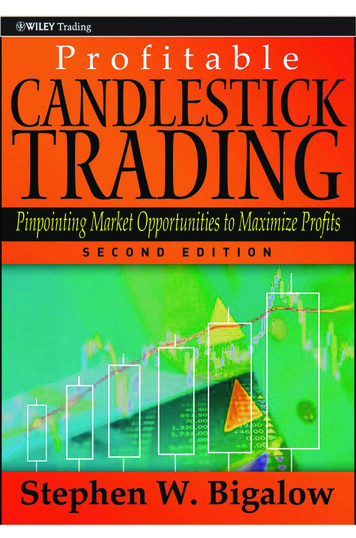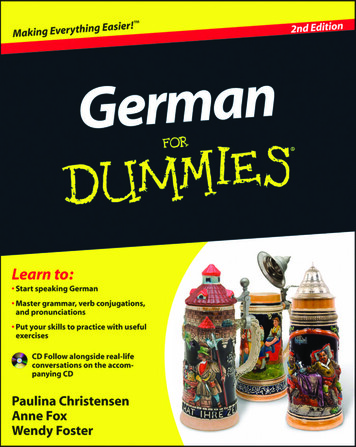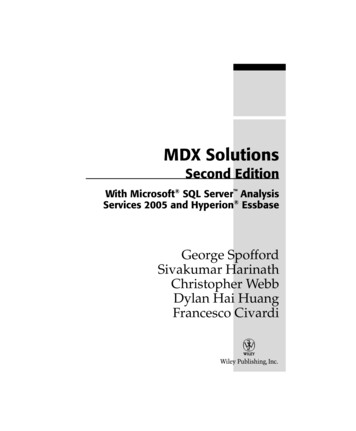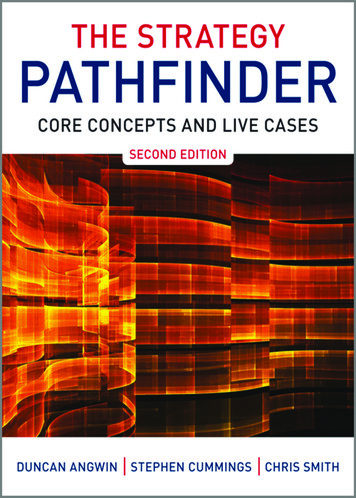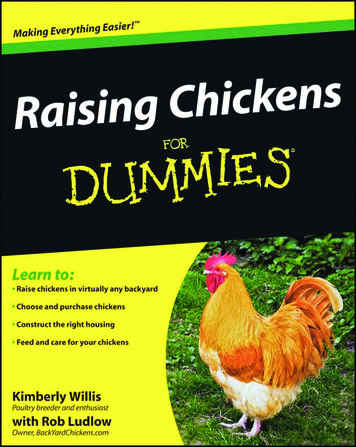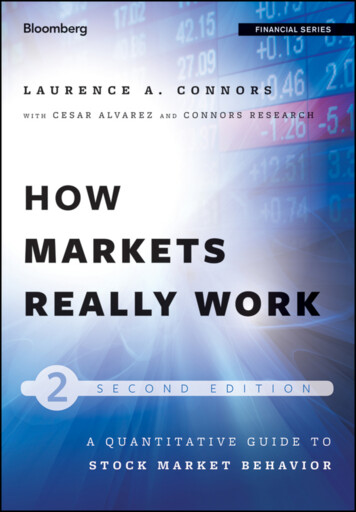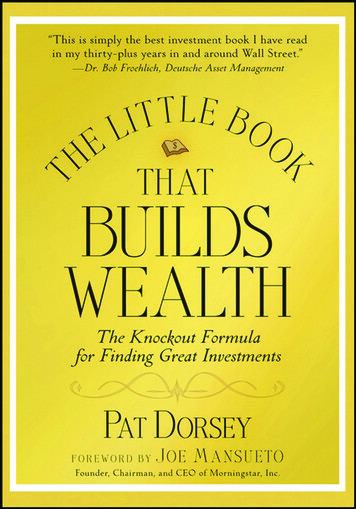
Transcription
TITTLE BOOLKHETHATBUILDSWEALTHThe Knockout Formulafor Finding Great InvestmentsPAT DORSEYFOREWORD BY JOE MANSUETOFOUNDER, CHAIRMAN, AND CEO OF MORNINGSTAR, INC.John Wiley & Sons, Inc.ffirs.indd v2/1/08 12:55:38 PM
ffirs.indd iv2/1/08 12:55:38 PM
TKHITTLE BOLOETHATBUILDSWEALTHffirs.indd i2/1/08 12:55:36 PM
Little Book Big Profits SeriesIn the Little Book Big Profits series, the brightest icons in the financialworld write on topics that range from tried-and-true investment strategies to tomorrow’s new trends. Each book offers a unique perspectiveon investing, allowing the reader to pick and choose from the verybest in investment advice today.Books in the Little Book Big Profits series include:The Little Book That Beats the Market, where Joel Greenblatt, founderand managing partner at Gotham Capital, reveals a “magic formula”that is easy to use and makes buying good companies at bargainprices automatic, enabling you to successfully beat the market andprofessional managers by a wide margin.The Little Book of Value Investing, where Christopher Browne, managing director of Tweedy, Browne Company, LLC, the oldest valueinvesting firm on Wall Street, simply and succinctly explains howvalue investing, one of the most effective investment strategies evercreated, works, and shows you how it can be applied globally.The Little Book of Common Sense Investing, where Vanguard Groupfounder John C. Bogle shares his own time-tested philosophies,lessons, and personal anecdotes to explain why outperforming themarket is an investor illusion, and how the simplest of investmentffirs.indd ii2/1/08 12:55:37 PM
strategies—indexing—can deliver the greatest return to the greatestnumber of investors.The Little Book That Makes You Rich, where Louis Navellier, financial analyst and editor of investment newsletters since 1980, offersreaders a fundamental understanding of how to get rich using thebest in growth investing strategies. Filled with in-depth insights andpractical advice, The Little Book That Makes You Rich outlines aneffective approach to building true wealth in today’s markets.The Little Book That Builds Wealth, where Pat Dorsey, director ofstock research for leading independent investment research providerMorningstar, Inc., guides the reader in understanding “economicmoats,” learning how to measure them against one another, andselecting the best companies for the very best returns.ffirs.indd iii2/1/08 12:55:37 PM
ffirs.indd iv2/1/08 12:55:38 PM
TITTLE BOOLKHETHATBUILDSWEALTHThe Knockout Formulafor Finding Great InvestmentsPAT DORSEYFOREWORD BY JOE MANSUETOFOUNDER, CHAIRMAN, AND CEO OF MORNINGSTAR, INC.John Wiley & Sons, Inc.ffirs.indd v2/1/08 12:55:38 PM
Copyright 2008 by Morningstar, Inc. All rights reserved.Published by John Wiley & Sons, Inc., Hoboken, New Jersey.Published simultaneously in Canada.No part of this publication may be reproduced, stored in a retrieval system, or transmitted in any form orby any means, electronic, mechanical, photocopying, recording, scanning, or otherwise, except aspermitted under Section 107 or 108 of the 1976 United States Copyright Act, without either the priorwritten permission of the Publisher, or authorization through payment of the appropriate per-copy fee tothe Copyright Clearance Center, Inc., 222 Rosewood Drive, Danvers, MA 01923, (978) 750-8400, fax(978) 646-8600, or on the web at www.copyright.com. Requests to the Publisher for permission should beaddressed to the Permissions Department, John Wiley & Sons, Inc., 111 River Street, Hoboken, NJ07030, (201) 748-6011, fax (201) 748-6008, or online at http://www.wiley.com/go/permissions.Limit of Liability/Disclaimer of Warranty: While the publisher and author have used their best effortsin preparing this book, they make no representations or warranties with respect to the accuracy orcompleteness of the contents of this book and specifically disclaim any implied warranties ofmerchantability or fitness for a particular purpose. No warranty may be created or extended by salesrepresentatives or written sales materials. The advice and strategies contained herein may not besuitable for your situation. You should consult with a professional where appropriate. Neither thepublisher nor author shall be liable for any loss of profit or any other commercial damages, includingbut not limited to special, incidental, consequential, or other damages.For general information on our other products and services or for technical support, please contact ourCustomer Care Department within the United States at (800) 762-2974, outside the United States at(317) 572-3993 or fax (317) 572-4002.Wiley also publishes its books in a variety of electronic formats. Some content that appears in printmay not be available in electronic books. For more information about Wiley products, visit our web siteat www.wiley.com.Library of Congress Cataloging-in-Publication Data:Dorsey, Pat.The little book that builds wealth : Morningstar’s knockout formula for finding great investments /Patrick Dorsey.p. cm.—(Little book big profits series)Includes index.ISBN 978-0-470-22651-3 (cloth)1. Investments. 2. Stocks. 3. Investment analysis. I. Morningstar, Inc. II. Title.HG4521.D6463 2008332.6—dc222007045591Printed in the United States of America.10ffirs.indd vi9876543212/1/08 12:55:38 PM
he Game Plan1Chapter OneEconomic Moats7Chapter TwoMistaken Moats15Chapter ThreeIntangible Assetsftoc.indd vii292/1/08 12:56:10 PM
[viii]C O N T E N TSChapter FourSwitching Costs43Chapter FiveThe Network Effect57Chapter SixCost Advantages75Chapter SevenThe Size Advantage91Chapter EightEroding Moats103Chapter NineFinding Moats115Chapter TenThe Big Boss133Chapter ElevenWhere the Rubber Meets the Roadftoc.indd viii1432/1/08 12:56:10 PM
C O N T E N TS[ix]Chapter TwelveWhat’s a Moat Worth?159Chapter ThirteenTools for Valuation171Chapter FourteenWhen to Sell187ConclusionMore than Numbersftoc.indd ix1972/1/08 12:56:10 PM
ftoc.indd x2/1/08 12:56:10 PM
Foreword WHEN I STARTED Morningstar in 1984, my goal was to helpindividuals invest in mutual funds. Back then, a few financialpublications carried performance data, and that was aboutit. By providing institutional-quality information at affordable prices, I thought we could meet a growing need.But I also had another goal. I wanted to build a businesswith an “economic moat.” Warren Buffett coined this term,which refers to the sustainable advantages that protect a company against competitors—the way a moat protects a castle.I discovered Buffett in the early 1980s and studied Berkshire Hathaway’s annual reports. There Buffett explains themoat concept, and I thought I could use this insight to helpflast.indd xi2/1/08 12:56:30 PM
[xii]F O R E WO R Dbuild a business. Economic moats made so much sense tome that the concept is the foundation for our company andfor our stock analysis.I saw a clear market need when I started Morningstar, but I also wanted a business with the potential for amoat. Why spend time, money, and energy only to watchcompetitors take away our customers?The business I envisioned would be hard for a competitor to replicate. I wanted Morningstar’s economic moat toinclude a trusted brand, large financial databases, proprietary analytics, a sizable and knowledgeable analyst staff,and a large and loyal customer base. With my backgroundin investing, a growing market need, and a business modelthat had wide-moat potential, I embarked on my journey.Over the past 23 years, Morningstar has achievedconsiderable success. The company now has revenues ofmore than 400 million, with above-average profitability.We’ve worked hard to make our moat broader and deeper,and we keep these goals in mind whenever we make newinvestments in our business.Moats, however, are also the basis of Morningstar’sapproach to stock investing. We believe investors shouldfocus their long-term investments on companies withwide economic moats. These companies can earn excessreturns for extended periods—above-average gains thatshould be recognized over time in share prices. There’sflast.indd xii2/1/08 12:56:30 PM
F O R E WO R D[xiii]another plus: You can hold these stocks longer, and thatreduces trading costs. So wide-moat companies are greatcandidates for anyone’s core portfolio.Many people invest by reacting: “My brother-in-lawrecommended it” or “I read about it in Money.” It’s alsoeasy to get distracted by daily price gyrations and punditswho pontificate about short-term market swings. Far betterto a have a conceptual anchor to help you evaluate stocksand build a rational portfolio. That’s where moats areinvaluable.While Buffett developed the moat concept, we’vetaken the idea one step further. We’ve identified the mostcommon attributes of moats, such as high switching costsand economies of scale, and provided a full analysis ofthese attributes. Although investing remains an art, we’veattempted to make identifying companies with moats moreof a science.Moats are a crucial element in Morningstar’s stockratings. We have more than 100 stock analysts covering2,000 publicly traded companies across 100 industries. Twomain factors determine our ratings: (1) a stock’s discountfrom our estimated fair value, and (2) the size of a company’s moat. Each analyst builds a detailed discounted cashflow model to arrive at a company’s fair value. The analystthen assigns a moat rating—Wide, Narrow, or None—based on the techniques that you’ll learn about in thisflast.indd xiii2/1/08 12:56:30 PM
[xiv]F O R E WO R Dbook. The larger the discount to fair value and the largerthe moat, the higher the Morningstar stock rating.We’re seeking companies with moats, but we want tobuy them at a significant discount to fair value. This is whatthe best investors do—legends like Buffett, Bill Nygren atOakmark Funds, and Mason Hawkins at Longleaf Funds.Morningstar, though, consistently applies this methodologyacross a broad spectrum of companies.This broad coverage gives us a unique perspective on thequalities that can give companies a sustainable competitiveadvantage. Our stock analysts regularly debate moats withtheir peers and defend their moat ratings to our senior staff.Moats are an important part of the culture at Morningstarand a central theme in our analyst reports.In this book, Pat Dorsey, who heads up our stockresearch at Morningstar, takes our collective experience andshares it with you. He gives you an inside look at the thoughtprocess we use in evaluating companies at Morningstar.Pat has been instrumental in the development of ourstock research and our economic moat ratings. He is sharp,well-informed, and experienced. We’re also fortunate thatPat is a top-notch communicator—both in writing andspeaking (you’ll often see him on television). As you’reabout to find out, Pat has a rare ability to explain investingin a clear and entertaining way.flast.indd xiv2/1/08 12:56:30 PM
F O R E WO R D[xv]In the pages that follow, Pat explains why we thinkmaking investment decisions based on companies’ economic moats is such a smart long-term approach—and,most important, how you can use this approach to buildwealth over time. You’ll learn how to identify companieswith moats and gain tools for determining how much astock is worth, all in a very accessible and engaging way.Throughout the book, you’ll learn about the economicpower of moats by studying how specific companies withwide moats have generated above-average profits overmany years—whereas businesses lacking moats have oftenfailed to create value for shareholders over time.Haywood Kelly, our chief of securities analysis, andCatherine Odelbo, president of our Individual Investorbusiness, have also played a central role in developingMorningstar’s stock research. Our entire stock analyststaff also deserves much credit for doing high-qualitymoat analysis on a daily basis.This book is short. But if you read it carefully, Ibelieve you’ll develop a solid foundation for making smartinvestment decisions. I wish you well in your investmentsand hope you enjoy our Little Book.—JOE MANSUETOFOUNDER, CHAIRMAN, AND CEO, MORNINGSTAR, INC.flast.indd xv2/1/08 12:56:31 PM
flast.indd xvi2/1/08 12:56:31 PM
Acknowledgments ANY BOOK IS A TEAM effort, and this one is no exception.I am very lucky to work with a group of extremely talented analysts, without whom I would know far less aboutinvesting than I do. The contributions of Morningstar’sEquity Analyst staff improved this book considerably,especially when it came to making sure I had just theright example to illustrate a particular point. It’s a blastto have such sharp colleagues—they make it fun to comein to work every day.Special thanks go to Haywood Kelly, Morningstar’schief of securities analysis, for valuable editorial feedback—and for hiring me at Morningstar many years ago. I’mflast.indd xvii2/1/08 12:56:31 PM
[xviii]A C K N OW L E D G M E N TSalso grateful to director of stock analysis Heather Brilliantfor quickly and seamlessly shouldering my managerialduties while I completed this book. Last but not least, ChrisCantore turned ideas into graphics, Karen Wallace tightened my prose, and Maureen Dahlen and Sara Mersingerkept the project on track. Thanks to all four.Credit is also due to Catherine Odelbo, president ofsecurities analysis, for her leadership of Morningstar’s equityresearch efforts, and of course to Morningstar founder JoeMansueto for building a world-class firm that always putsinvestors first. Thanks, Joe.No one, however, deserves more gratitude than mywife Katherine, whose love and support are my most precious assets. Along with little Ben and Alice, our twins,she brings happiness to each day.flast.indd xviii2/1/08 12:56:31 PM
TKHITTLE BOLOETHATBUILDSWEALTHflast.indd xix2/1/08 12:56:32 PM
flast.indd xx2/1/08 12:56:32 PM
IntroductionThe Game Plan THERE ARE LOTS OF WAYS to make money in the stock market.You can play the Wall Street game, keep a sharp eye ontrends, and try to guess which companies will beat earningsestimates each quarter, but you’ll face quite a lot of competition. You can buy strong stocks with bullish chart patternsor superfast growth, but you’ll run the risk that no buyerswill emerge to take the shares off your hands at a higherprice. You can buy dirt-cheap stocks with little regard forthe quality of the underlying business, but you’ll have tobalance the outsize returns in the stocks that bounce backwith the losses in those that fade from existence.cintro.indd 11/26/08 3:14:59 AM
[2]T H E L I T T L E B O O K T H AT B U I L D S W E A LT HOr you can simply buy wonderful companies at reasonable prices, and let those companies compound cashover long periods of time. Surprisingly, there aren’t allthat many money managers who follow this strategy, eventhough it’s the one used by some of the world’s most successful investors. (Warren Buffett is the best-known.)The game plan you need to follow to implement thisstrategy is simple:1. Identify businesses that can generate above-averageprofits for many years.2. Wait until the shares of those businesses trade forless than their intrinsic value, and then buy.3. Hold those shares until either the business deteriorates, the shares become overvalued, or you find abetter investment. This holding period should bemeasured in years, not months.4. Repeat as necessary.This Little Book is largely about the first step—findingwonderful businesses with long-term potential. If you cando this, you’ll already be ahead of most investors. Later inthe book, I’ll give you some tips on valuing stocks, as wellas some guidance on when you want to sell a stock andmove on to the next opportunity.cintro.indd 21/26/08 3:14:59 AM
THE GAME PLAN[3]Why is it so important to find businesses that can crankout high profits for many years? To answer this question,step back and think about the purpose of a company, whichis to take investors’ money and generate a return on it. Companies are really just big machines that take in capital, investit in products or services, and either create more capital(good businesses) or spit out less capital than they took in(bad businesses). A company that can generate high returnson its capital for many years will compound wealth at a veryprodigious clip.*Companies that can do this are not common, however, because high returns on capital attract competitorslike bees to honey. That’s how capitalism works, afterall—money seeks the areas of highest expected return,which means that competition quickly arrives at the doorstep of a company with fat profits.So in general, returns on capital are what we call“mean-reverting.” In other words, companies with highreturns see them dwindle as competition moves in, and*Return on capital is the best benchmark of a company’s profitability. Itmeasures how effectively a company uses all of its assets—factories, people,investments—to make money for shareholders. You might think of it inthe same way as the return achieved by the manager of a mutual fund, except that a company’s managers invest in projects and products rather thanstocks and bonds. More about return on capital in Chapter 2.cintro.indd 31/26/08 3:14:59 AM
[4]T H E L I T T L E B O O K T H AT B U I L D S W E A LT Hcompanies with low returns see them improve as either theymove into new lines of business or their competitors leavethe playing field.But some companies are able to withstand the relentless onslaught of competition for long periods of time, andthese are the wealth-compounding machines that can formthe bedrock of your portfolio. For example, think aboutcompanies like Anheuser-Busch, Oracle, and Johnson &Johnson—they’re all extremely profitable and have facedintense competitive threats for many years, yet they stillcrank out very high returns on capital. Maybe they justgot lucky, or (more likely) maybe those firms have somespecial characteristics that most companies lack.How can you identify companies like these—ones thatnot only are great today, but are likely to stay great formany years into the future? You ask a deceptively simplequestion about the companies in which you plan to invest:“What prevents a smart, well-financed competitor frommoving in on this company’s turf ?”To answer this question, look for specific structuralcharacteristics called competitive advantages or economicmoats. Just as moats around medieval castles kept theopposition at bay, economic moats protect the highreturns on capital enjoyed by the world’s best companies.If you can identify companies that have moats and youcan purchase their shares at reasonable prices, you’ll buildcintro.indd 41/26/08 3:15:00 AM
THE GAME PLAN[5]a portfolio of wonderful businesses that will greatlyimprove your odds of doing well in the stock market.So, what is it about moats that makes them so special? That’s the subject of Chapter 1. In Chapter 2, Ishow you how to watch out for false positives—companycharacteristics that are commonly thought to confercompetitive advantage, but actually are not all that reliable. Then we’ll spend several chapters digging into thesources of economic moats. These are the traits thatendow companies with truly sustainable competitive advantages, so we’ll spend a fair amount of time understandingthem.That’s the first half of this book. Once we’ve established a foundation for understanding economic moats,I’ll show you how to recognize moats that are eroding,the key role that industry structure plays in creating competitive advantage, and how management can create (anddestroy) moats. A chapter of case studies follows thatapplies competitive analysis to some well-known companies. I’ll also give an overview of valuation, because evena wide-moat company will be a poor investment if you paytoo much for its shares.cintro.indd 51/26/08 3:15:00 AM
cintro.indd 61/26/08 3:15:00 AM
apthCer OneEconomic Moats What’s an Economic Moat, andHow Will It Help You PickGreat Stocks?FOR MOST PEOPLE, it’s common sense to pay more for something that is more durable. From kitchen appliances to carsto houses, items that will last longer are typically able tocommand higher prices, because the higher up-front costwill be offset by a few more years of use. Hondas cost morethan Kias, contractor-quality tools cost more than thosefrom a corner hardware store, and so forth.c01.indd 71/26/08 3:05:57 AM
[8]T H E L I T T L E B O O K T H AT B U I L D S W E A LT HThe same concept applies to the stock market. Durablecompanies—that is, companies that have strong competitiveadvantages—are more valuable than companies that are atrisk of going from hero to zero in a matter of monthsbecause they never had much of an advantage over theircompetition. This is the biggest reason that economicmoats should matter to you as an investor: Companies withmoats are more valuable than companies without moats.So, if you can identify which companies have economicmoats, you’ll pay up for only the companies that are reallyworth it.To understand why moats increase the value of companies, let’s think about what determines the value of a stock.Each share of a company gives the investor a (very) smallownership interest in that firm. Just as an apartment building is worth the present value of the rent that will be paid byits tenants, less maintenance expenses, a company is worththe present value* of the cash we expect it to generate overits lifetime, less whatever the company needs to spend onmaintaining and expanding its business.*To calculate present value, we adjust the sum of those future cash flowsfor their timing and certainty. A dollar in the hand is more valuable thanone in the bush, so to speak, and cash we’re confident of receiving in thefuture is worth more than cash flows we’re less certain about receiving. I’llgo over some basic valuation principles in Chapters 12 and 13, so don’tworry if this isn’t clear just yet.c01.indd 81/26/08 3:05:57 AM
E C O N O M I C M O AT S[9]So, let’s compare two companies, both growing atabout the same clip, and both employing about the sameamount of capital to generate the same amount of cash.One company has an economic moat, so it should be ableto reinvest those cash flows at a high rate of return for adecade or more. The other company does not have a moat,which means that returns on capital will likely plummet assoon as competitors move in.The company with the moat is worth more today becauseit will generate economic profits for a longer stretch of time.When you buy shares of the company with the moat, you’rebuying a stream of cash flows that is protected from competition for many years. It’s like paying more for a car that youcan drive for a decade versus a clunker that’s likely to conkout in a few years.In Exhibit 1.1, time is on the horizontal axis, andreturns on invested capital are on the vertical axis. Youcan see that returns on capital for the company on the leftside—the one with the economic moat—take a long timeto slowly slide downward, because the firm is able to keepcompetitors at bay for a longer time. The no-moat company on the right is subject to much more intense competition, so its returns on capital decline much faster. Thedark area is the aggregate economic value generated byeach company, and you can see how much larger it is forthe company that has a moat.c01.indd 91/26/08 3:05:58 AM
[ 10 ]T H E L I T T L E B O O K T H AT B U I L D S W E A LT HCompany with an Economic MoatCompany without an Economic MoatReturn on Invested CapitalReturn on Invested CapitalEXHIBIT 1.1 Company with an Economic Moat versus a Companywithout a MoatTime HorizonTime HorizonSo, a big reason that moats should matter to you asan investor is that they increase the value of companies.Identifying moats will give you a big leg up on pickingwhich companies to buy, and also on deciding what priceto pay for them.Moats Matter for Lots of ReasonsWhy else should moats be a core part of your stock-picking process?Thinking about moats can protect your investmentcapital in a number of ways. For one thing, it enforcesinvestment discipline, making it less likely that you willoverpay for a hot company with a shaky competitiveadvantage. High returns on capital will always be competed away eventually, and for most companies—and theirinvestors—the regression is fast and painful.c01.indd 101/26/08 3:05:58 AM
E C O N O M I C M O AT S[ 11 ]Think of all the once-hot teen retailers whose brandsare now deader than a hoop skirt, or the fast-growingtechnology firms whose competitive advantage disappeared overnight when another firm launched a betterwidget into the market. It’s easy to get caught up in fatprofit margins and fast growth, but the duration of thosefat profits is what really matters. Moats give us a framework for separating the here-today-and-gone-tomorrowstocks from the companies with real sticking power.Also, if you are right about the moat, your odds of permanent capital impairment—that is, irrevocably losing a tonof money on your investment—decline considerably. Companies with moats are more likely to reliably increase theirintrinsic value over time, so if you wind up buyingtheir shares at a valuation that (in hindsight) is somewhathigh, the growth in intrinsic value will protect your investment returns. Companies without moats are more likely tosuffer sharp, sudden decreases in their intrinsic value whenthey hit competitive speed bumps, and that means you’llwant to pay less for their shares.Companies with moats also have greater resilience,because firms that can fall back on a structural competitive advantage are more likely to recover from temporarytroubles. Think about Coca-Cola’s disastrous launches ofNew Coke years ago, and C2 more recently—they wereboth complete flops that cost the company a lot of money,c01.indd 111/26/08 3:05:58 AM
[12]T H E L I T T L E B O O K T H AT B U I L D S W E A LT Hbut because Coca-Cola could fall back on its core brand,neither mistake killed the company.Coke also was very slow to recognize the shift in consumer preferences toward noncarbonated beverages such aswater and juice, and this was a big reason behind the firm’sanemic growth over the past several years. But because Cokecontrols its distribution channel, it managed to recover somewhat by launching Dasani water and pushing other newlyacquired noncarbonated brands through that channel.Or look back to McDonald’s troubles in the earlypart of this decade. Quick-service restaurants are anincredibly competitive business, so you’d think that a firmthat let customer service degrade and failed to stay intouch with changing consumer tastes would have beencomplete toast. And in fact, that’s the way the businesspress largely portrayed Mickey D’s in 2002 and 2003. YetMcDonald’s iconic brand and massive scale enabled it toretool and bounce back in a way that a no-moat restaurantchain could not have done.This resiliency of companies with moats is a huge psychological backstop for an investor who is looking to buywonderful companies at reasonable prices, because highquality firms become good values only when somethinggoes awry. But if you analyze a company’s moat prior to itbecoming cheap—that is, before the headlines changefrom glowing to groaning—you’ll have more insight intowhether the firm’s troubles are temporary or terminal.c01.indd 121/26/08 3:05:58 AM
E C O N O M I C M O AT S[13]Finally, moats can help you define what is called a“circle of competence.” Most investors do better if theylimit their investing to an area they know well—financialservices firms, for example, or tech stocks—rather thantrying to cast too broad a net. Instead of becoming anexpert in a set of industries, why not become an expert infirms with competitive advantages, regardless of whatbusiness they are in? You’ll limit a vast and unworkableinvestment universe to a smaller one composed of highquality firms that you can understand well.You’re in luck, because that’s exactly what I want todo for you with this book: make you an expert at recognizing economic moats. If you can see moats where othersdon’t, you’ll pay bargain prices for the great companies oftomorrow. Of equal importance, if you can recognize nomoat businesses that are being priced in the market as ifthey have durable competitive advantages, you’ll avoidstocks with the potential to damage your portfolio.The Bottom Line1. Buying a share of stock means that you own atiny—okay, really tiny—piece of the business.2. The value of a business is equal to all the cash itwill generate in the future.(continued)c01.indd 131/26/08 3:05:58 AM
[14]T H E L I T T L E B O O K T H AT B U I L D S W E A LT H3. A business that can profitably generate cash fora long time is worth more today than a businessthat may be profitable only for a short time.4. Return on capital is the best way to judge acompany’s profitability. It measures how gooda company is at taking investors’ money and generating a return on it.5. Economic moats can protect companies fromcompetition, helping them earn more money fora long time, and therefore making them morevaluable to an investor.c01.indd 141/26/08 3:05:59 AM
apte r TwohCMistaken Moats Don’t Be Fooled by These IllusoryCompetitive Advantages.THERE’S A COMMON CANARD in investing that runs, “Bet onthe jockey, not on the horse”—the notion is that the qualityof a management team matters more than the quality of abusiness. I suppose that in horse racing it makes sense. Afterall, racing horses are bred and trained to run fast, and so theplaying field among horses seems relatively level. I may be onthin ice here, having never actually been to a horse race, butI think it’s fair to say that mules and Shetland ponies don’trace against thoroughbreds.c02.indd 151/26/08 3:06:29 AM
[16]T H E L I T T L E B O O K T H AT B U I L D S W E A LT HThe business world is different. In the stock market,mules and Shetland po
Little Book Big Profits Series In the Little Book Big Profits series, the brightest icons in the financial world write on topics that range from tried-and-true investment strate-gies to tomorrow’s new trends. Each book offers a unique perspective on investing, allowing the reader to pick
